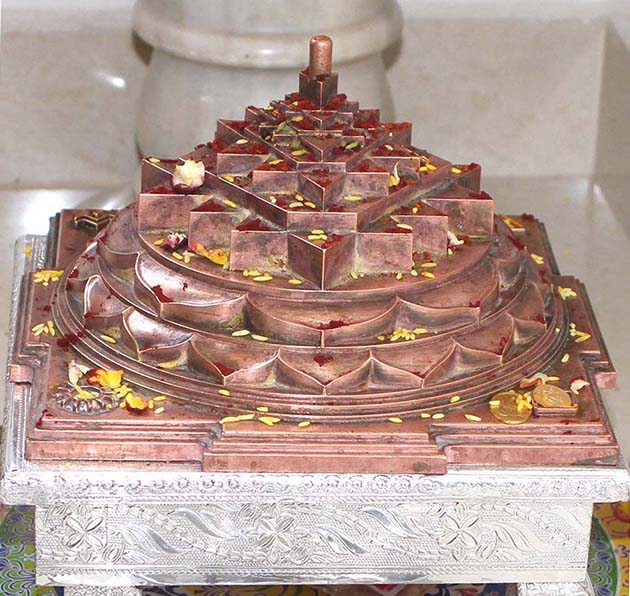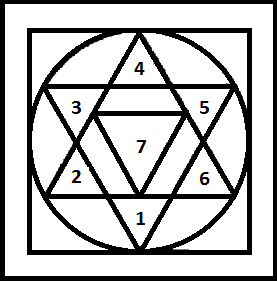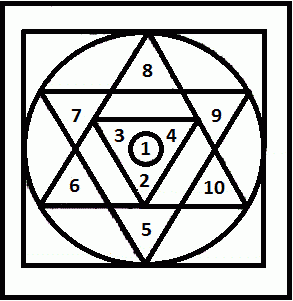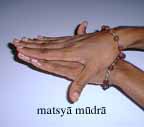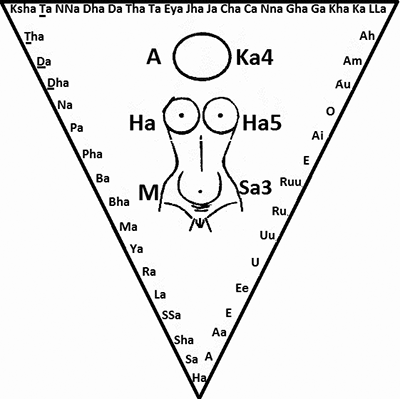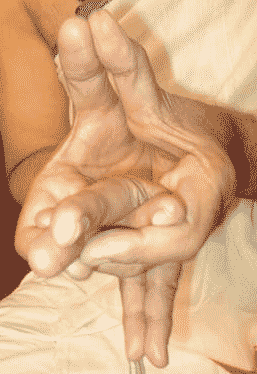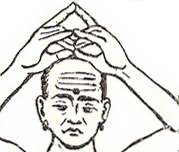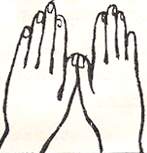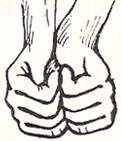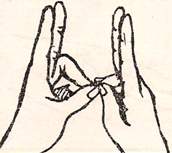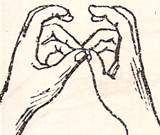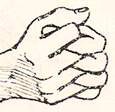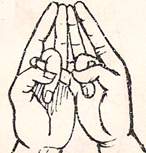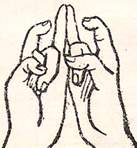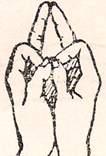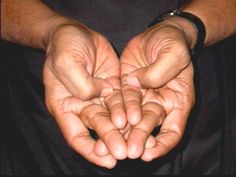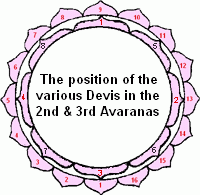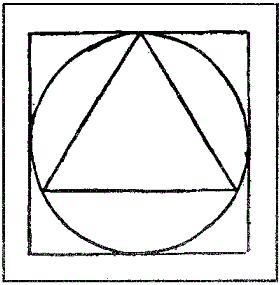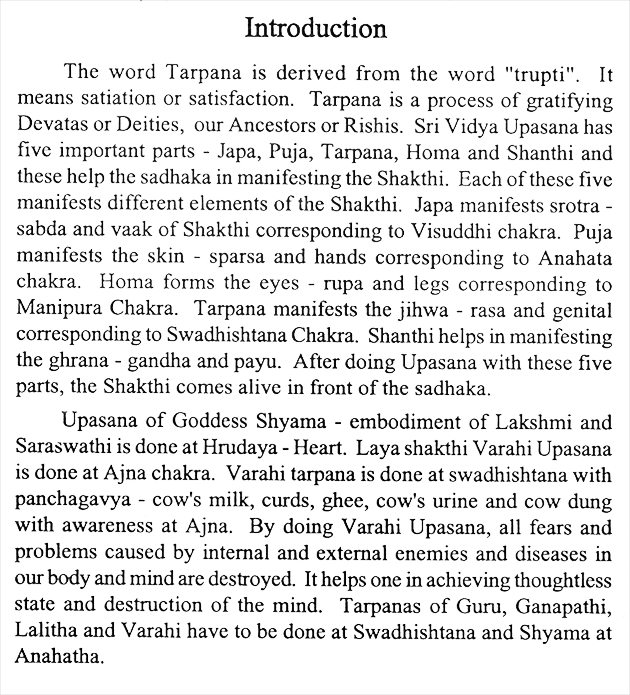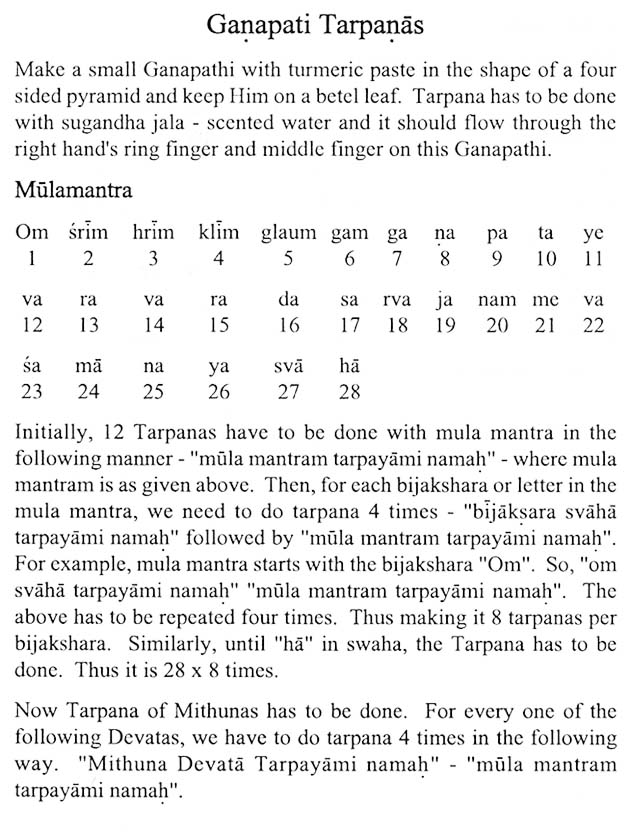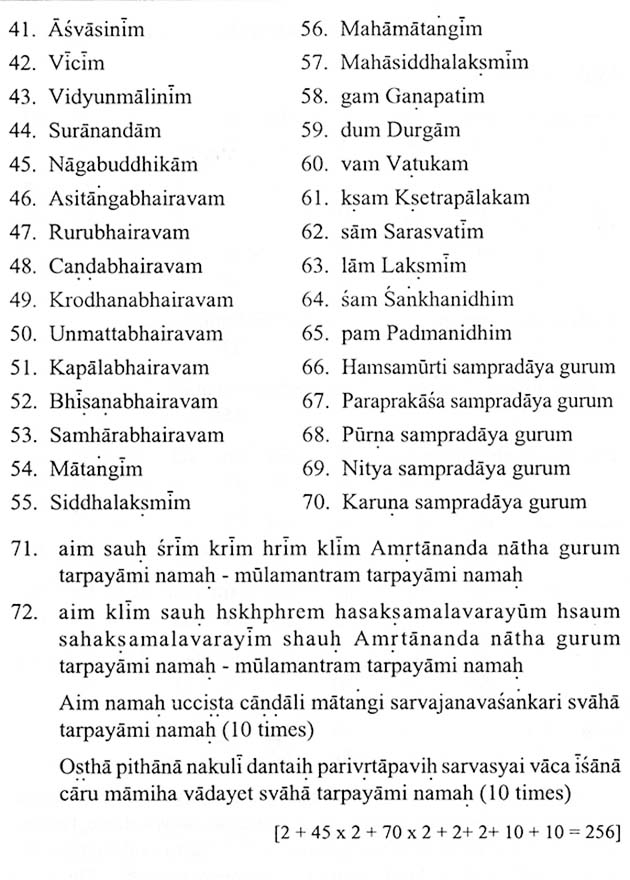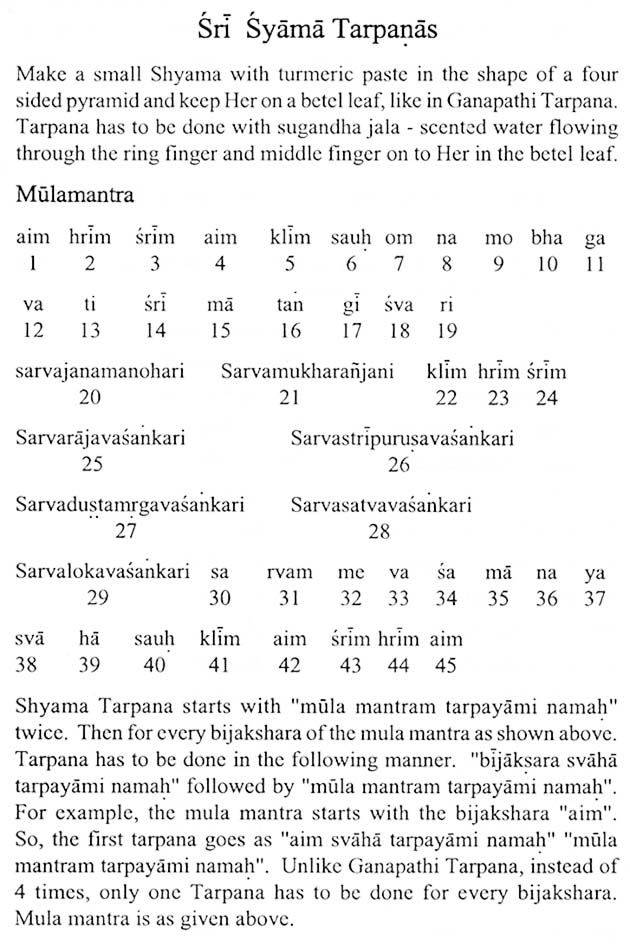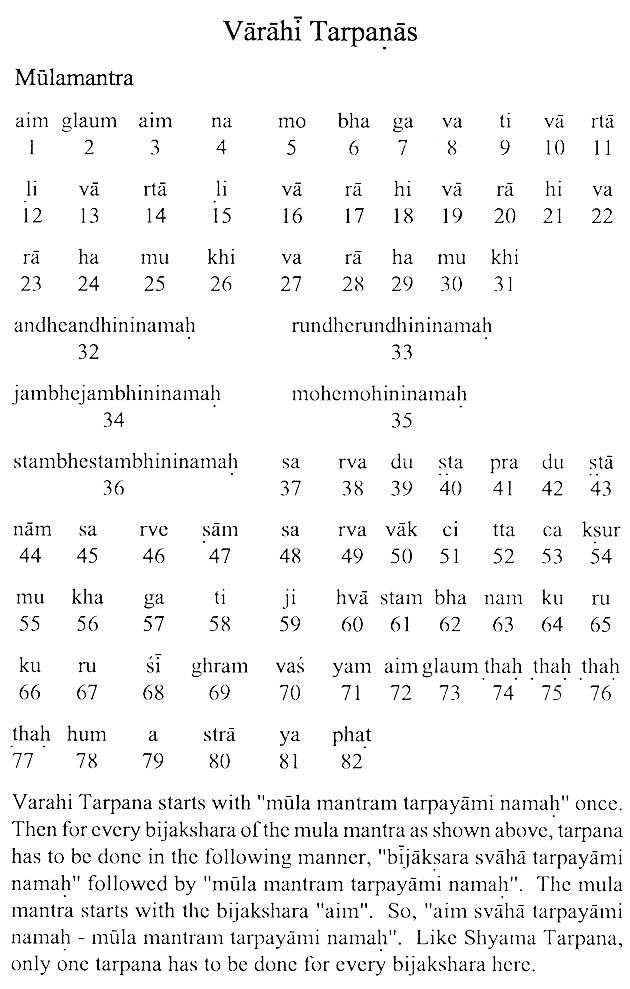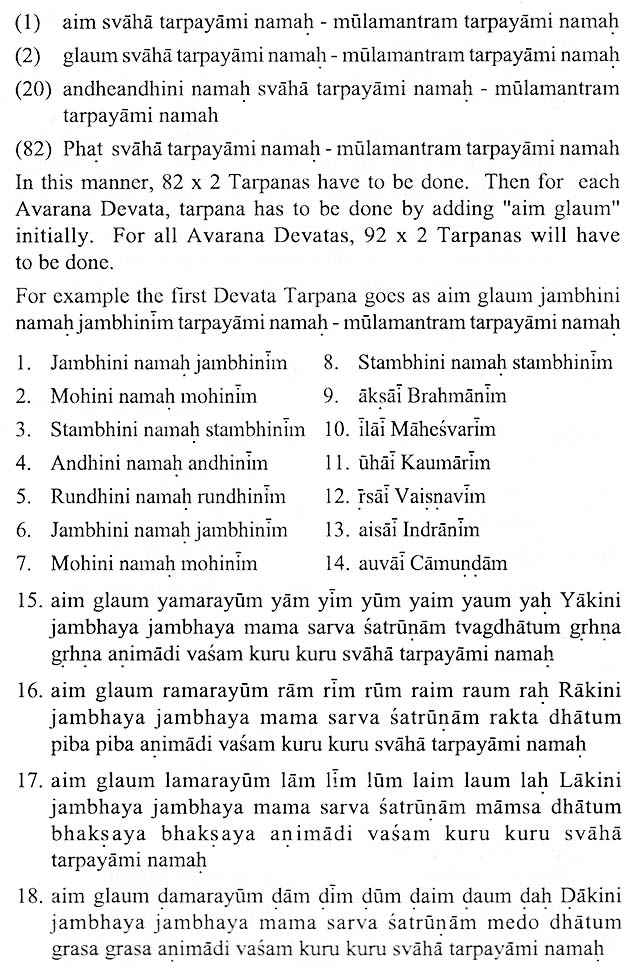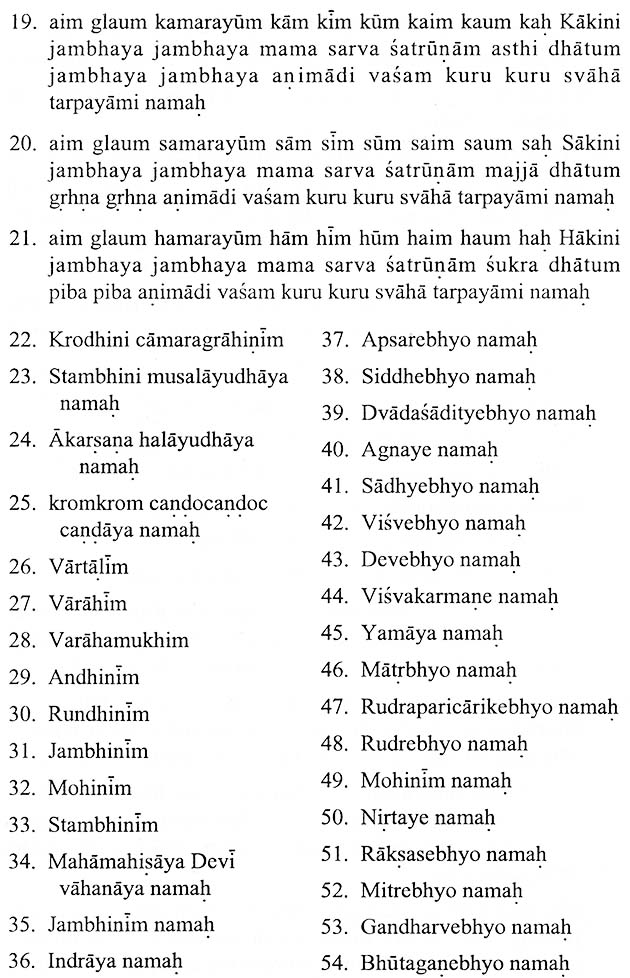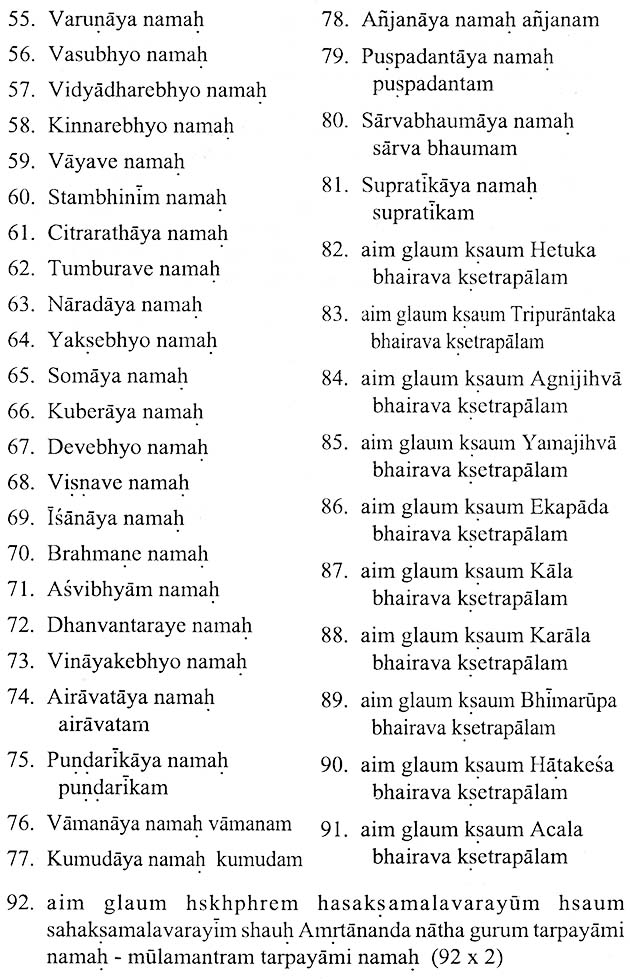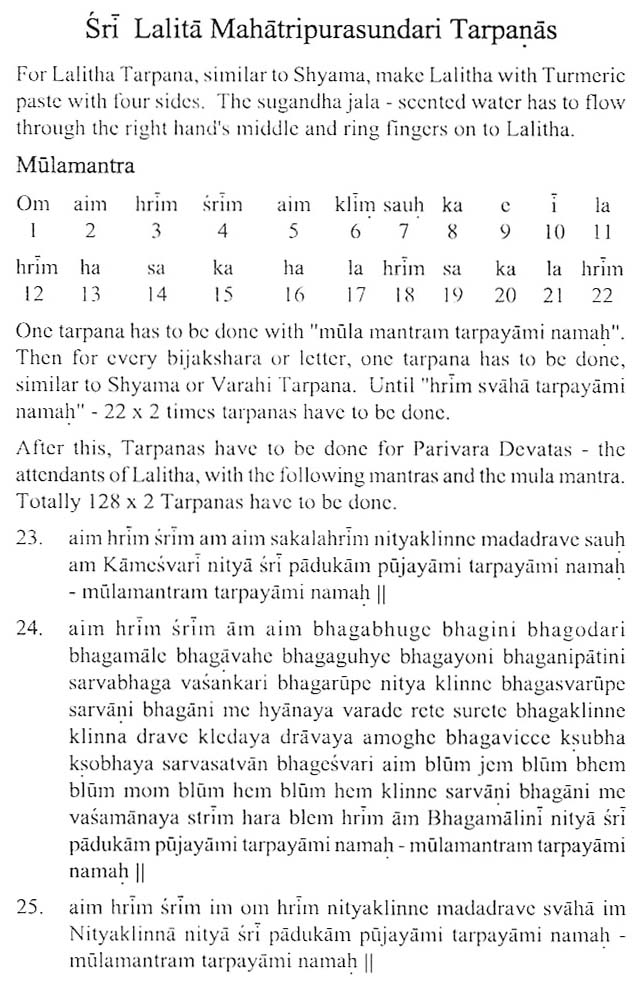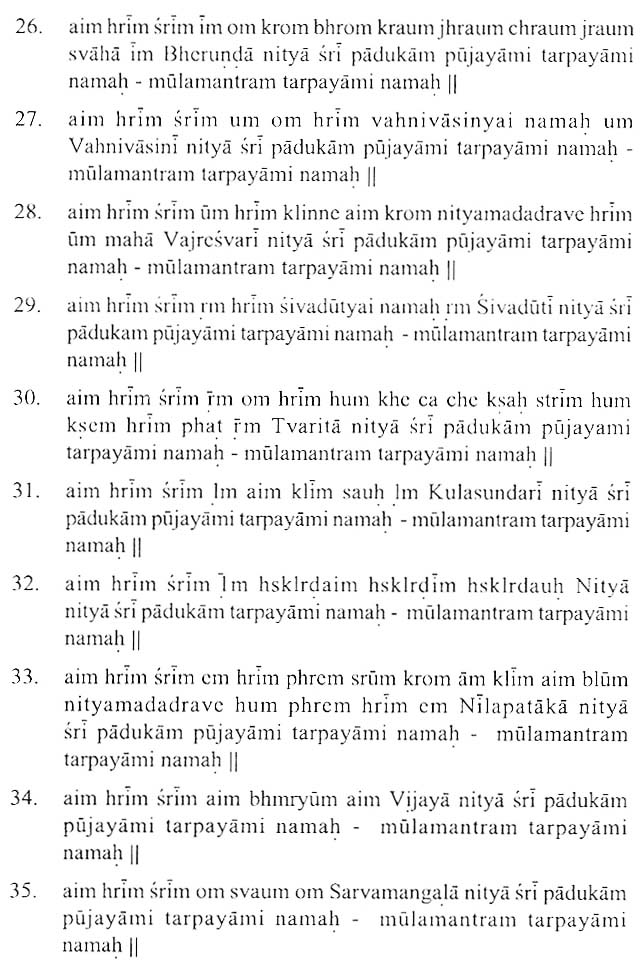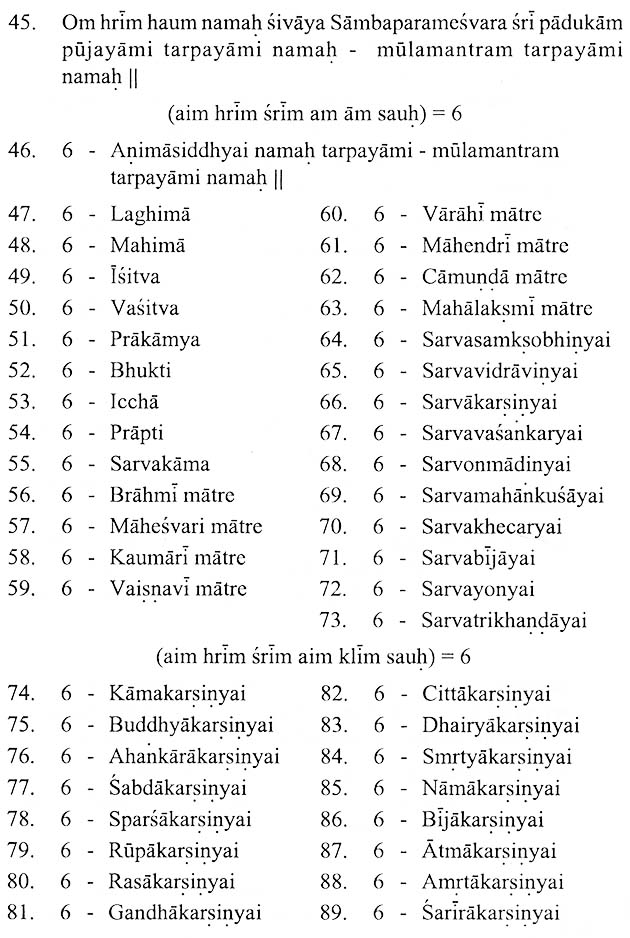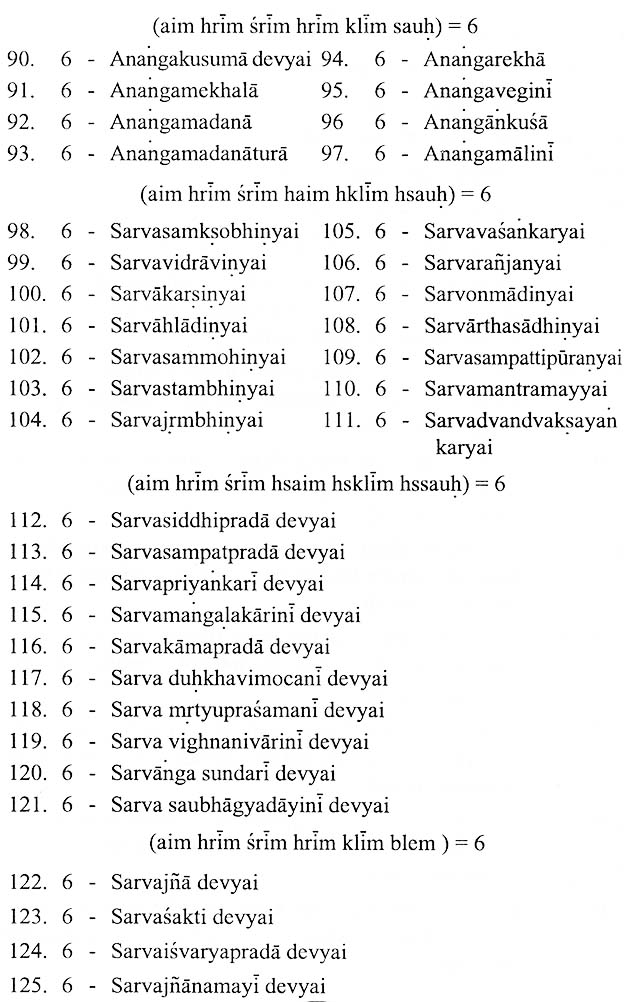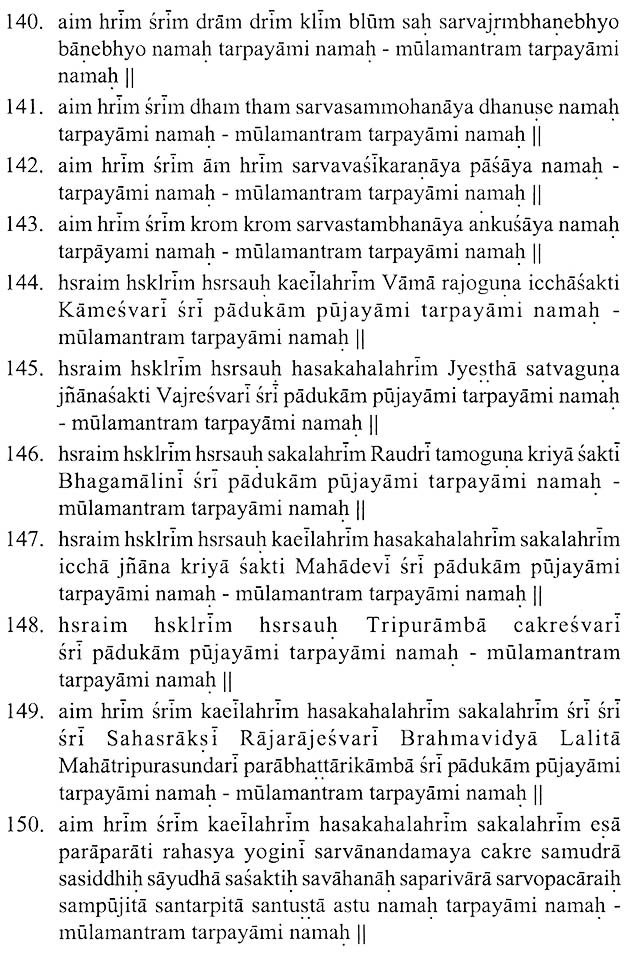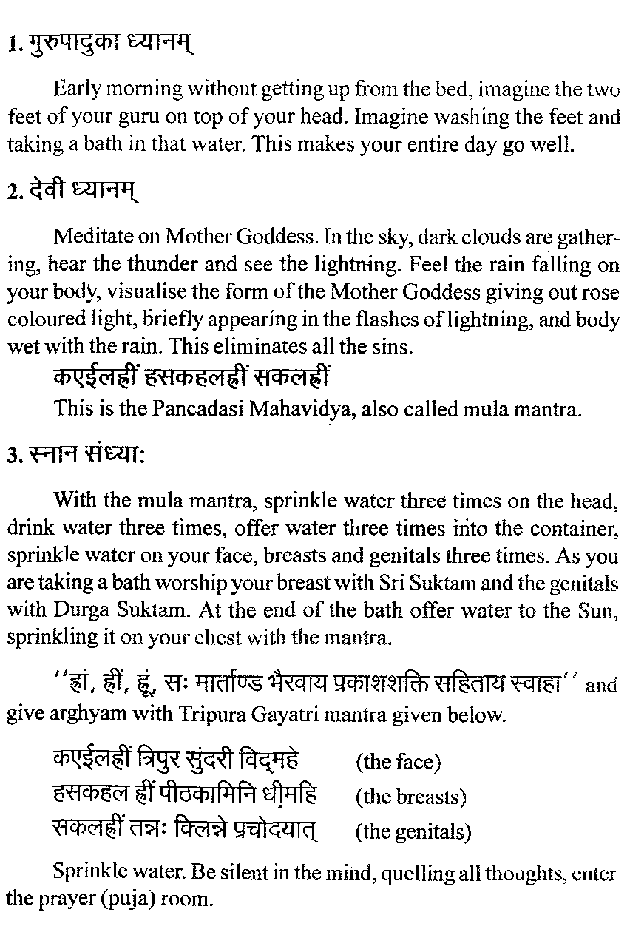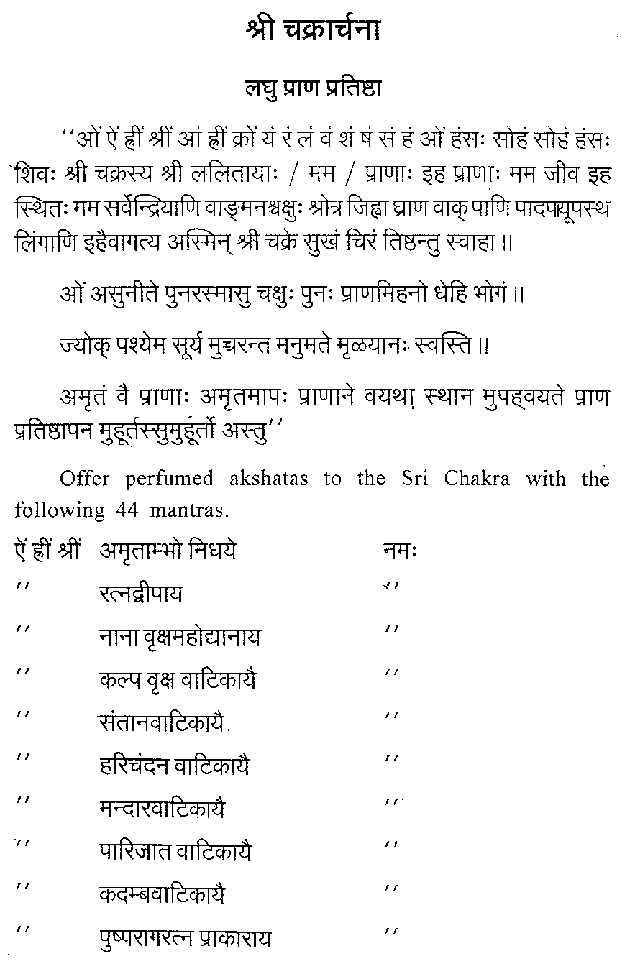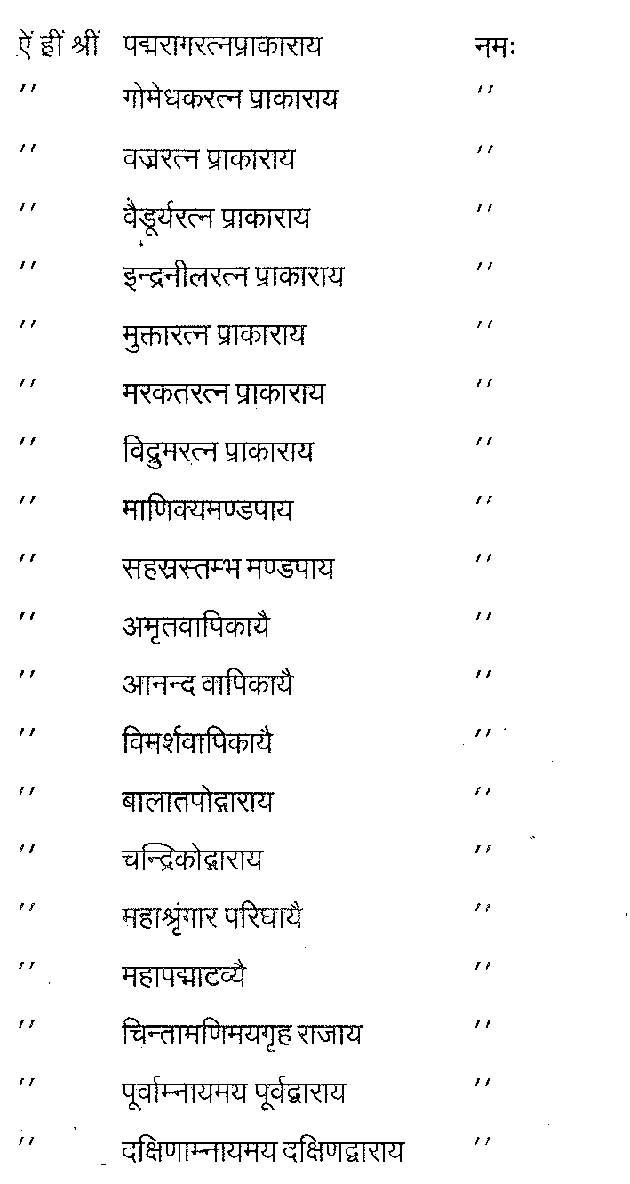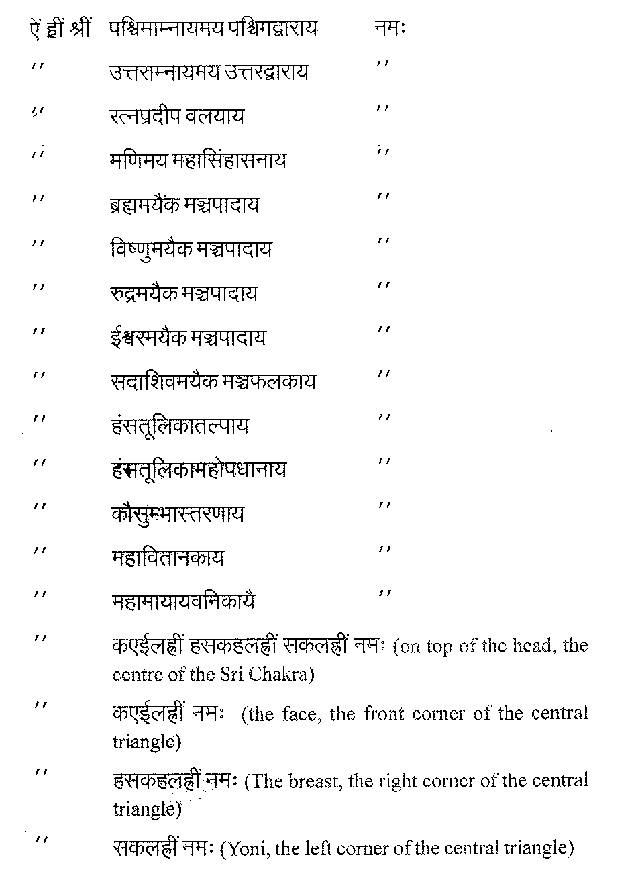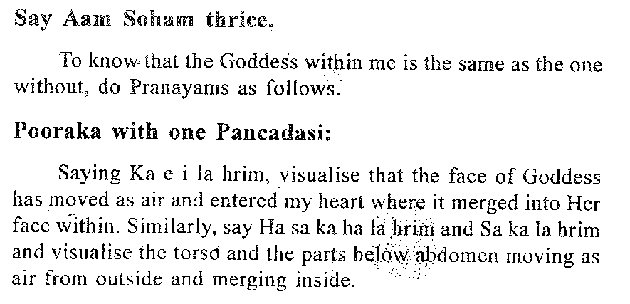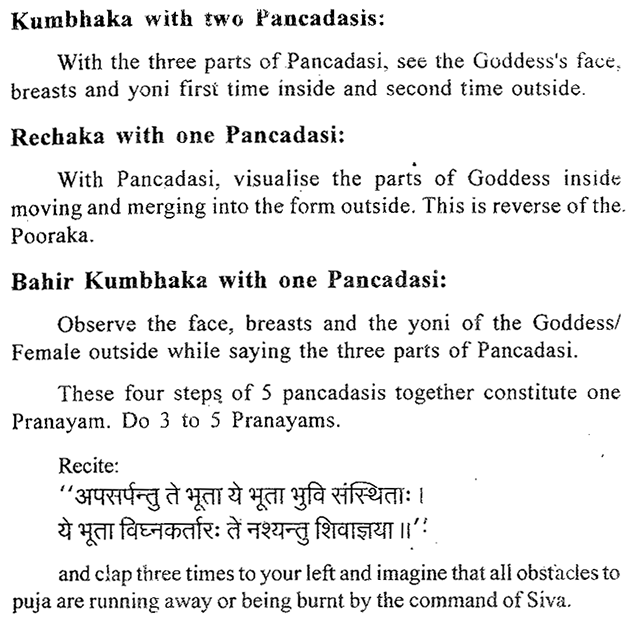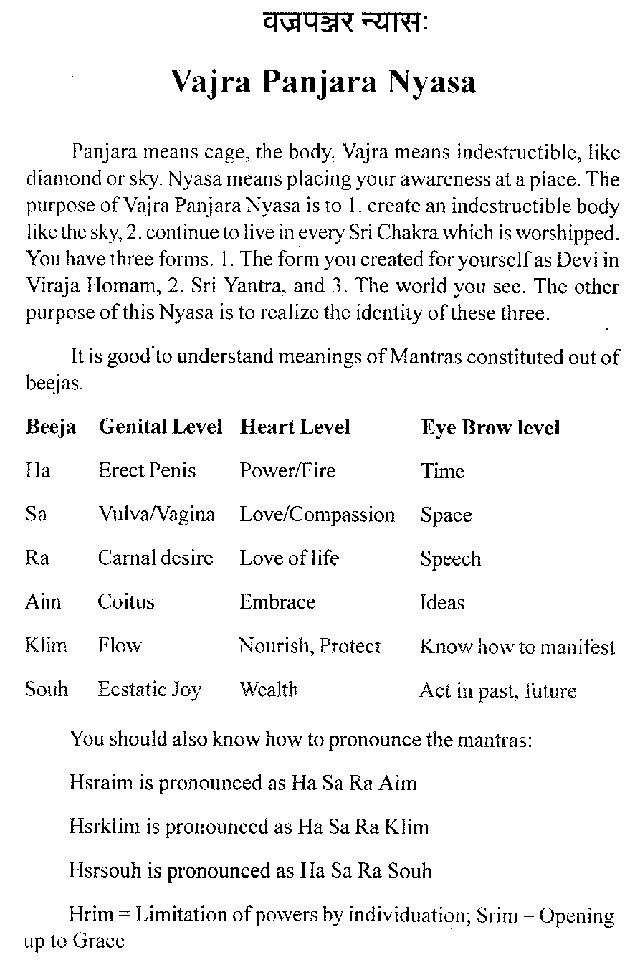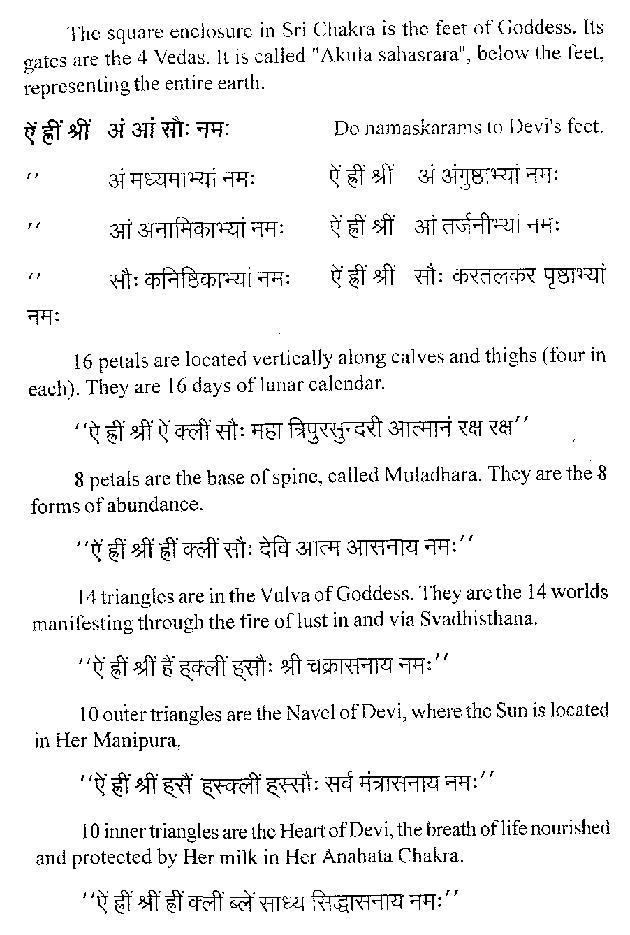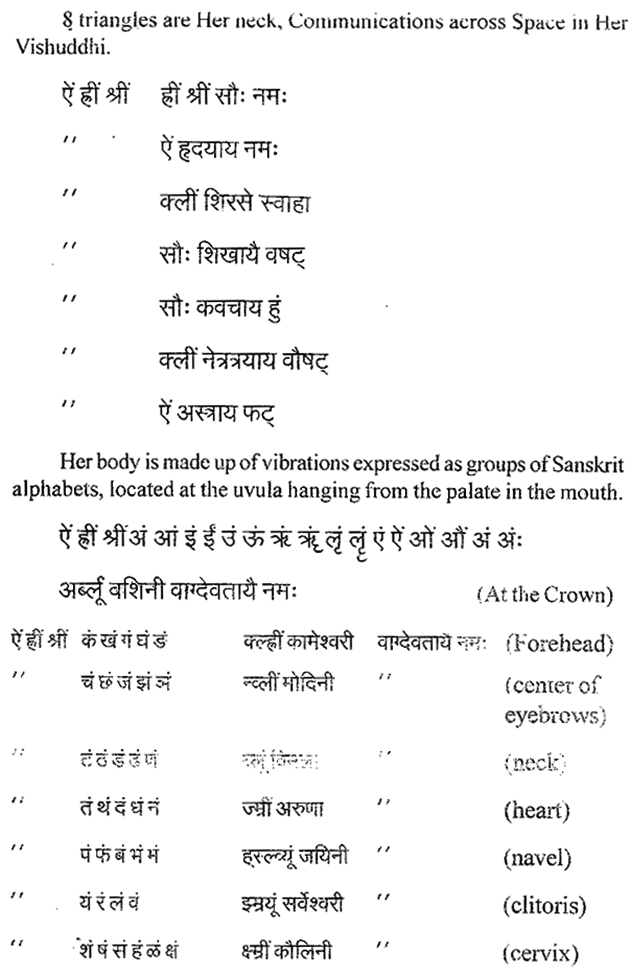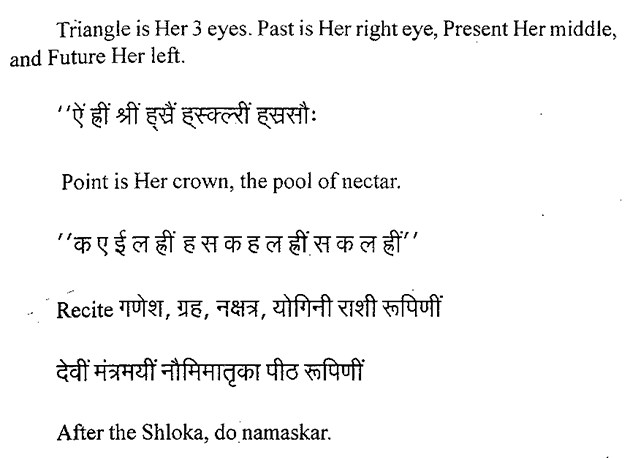CHAPTER SIXTEEN
The Killing of the Raksasi, Kuthodari
Text 1
Suta GosvamI said. After killing the Buddhists and mlecchas of Kikatapura, Lord Kalki took their wealth and returned to His capital, along with His vast army.
Text 2
Lord Kalki, the unhmitedly powerful protector of religious principles, next went to Cakratlrtha and took a ritualistic bath, according to prescribed procedure.
Text3
One day, as the Lord was sitting in His assembly, surrounded by the lokapalas,His relatives, and other associates, He saw that some miserable- looking sages were approaching.
Texts 4-6
These sages had come out of fear and they pleaded: О master of the universe, please protect us.
These sages were the Balakhilyas. They were very short in stature, they were crowned with matted hair, and they wore torn cloth. Lord Hari inquired: Where are you coming from? Who are you afraid of? I will kill him, even if he is the lord of the demigods.
Text7
When the sages heard the Lord give them this assurance, their happiness knew no bounds. Thereafter, the sages narrated the story of Nikumbha’s daughter.
Text8
The sages said: My dear Lord, please hear our prayer. Kumbhakarna’s son, Nikumbha, has a daughter named Kuthodarl. She is so tall that she reaches half way to the sky.
Text 9
Her husband’s name is Kalakanja. This demoniac couple has a son named Vikanja. Just now, Kuthodari is lying down, breast-feeding her son, Vikanja. Her head rests on the Himalaya mountains and her legs reach to the Nisadha mountain.
Text 10
We have been pushed here by the force of her strong breath and so we consider it to be the arrangement of providence that we have met You. Now, kindly save us from the wrath of this Raksasl.
Text 11
After hearing this from the sages, Lord Kalki immediately left for the Himalayas, accompanied by His army.
Texts 12ЛЗ
The Lord passed the first night in a valley, and as He was about to proceed the next morning, He spotted a river of milk. The river was broad and white, like a conch shell, or moon rays, and it flowed very swiftly, so that everyone became astonished to see it.
Texts 14-16
Even though Lord Kalki knew very well about that river, He nevertheless questioned the sages, who were accompanying Him: What is the name of this river? Why is it filled with milk, and not water? The sages replied. My dear Lord, we will disclose to You the truth of this river. This river has been created from the milk that flows from one of Kuthodarl’s breasts.
Text 17
After seven hours, another similar river will be created. After some time, this river of milk will freeze to become a sheet of white ice.
Text 18
Upon hearing this from the sages, Lord Kalki and His soldiers exclaimed: Alas! How wonderful this is A river has been created from the breast milk of a Raksasi!
Text 19
This Raksasi affectionately feeds the milk from one of her breasts to her son, Vikanja. The size of that Raksasl’s body is beyond anyone’s imagination.
Text 20
Alas! Who can estimate the strength of that Raksasi?
As they were discussing the Raksasi in this way, Lord Kalki and His soldiers approached her, who hunts her prey at night.
Text 21
With the assistance of the great sages, Lord Kalki ascended the mountains until He finally spotted the Raksasi with a very dark complexion sitting on the peak of a mountain, breast-feeding her son.
Text 22
She breathed so heavily that even wild elephants were thrown far away into the forest. Lord Kalki and his soldiers were astonished to see lions sleeping peacefully inside the cavities of her ears.
Text 23
Deer were sleeping in the pores of her body, along with their calves, having mistaken them to be mountain caves. They were freed from all fear of hunters and so the deer clung to the Raksasi’s body like lice in a person’s hair.
Texts 24-25
Upon seeing the Raksasi, who resembled a dark mountain, lying on a mountain peak, the lotus-petal eyed Lord Kalki gave assurances to His soldiers, who had become very frightened and had thus lost the will to fight and were preparing to throw down their weapons.
Text 26
Lord Kalki said: The infantry soldiers should construct a fort on this mountain and while remaining within, they should keep it surrounded by fire at all times. The rest of you warriors should mount your horses, elephants, and chariots and accompany Me as I accomplish My mission.
Text 27
My strategy is that I will take only few soldiers and challenge the Raksasi while showering our arrows, swords, and axes.
Text 28
After saying this, Lord Kalki left His vast army and approached the Raksasi while showering torrents of arrows upon her. At this, the Raksasi began to scream with rage.
Text 29
Her screams were so loud that everyone’s senses were stunned. What to speak of the ordinary soldiers, even the generals fell unconscious onto the ground.
Text 30
Kuthodarl, the ferocious RaksasI, then opened her mouth wide and swallowed all the chariots, elephants, and horses after pulling them toward her by her powerful inhalation.
Text 31
When a bear breathes heavily, many insects and ants are drawn into his mouth. In the same way, Lord Kalki and His soldiers were forced to helplessly enter the Raksasfs mouth.
Text 32
This stunned all the demigods and Gandharvas who were watching from the heavens, and made them bitterly lament. Some great sages cursed the RaksasI while others recited prayers and mantras for the welfare of Lord Kalki.
Text 33
Many qualified brahmanas simply watched quietly, unable to even attempt to counteract their great distress. The devotees of Lord Kalki cried out in frustration, whereas the demons shouted with glee.
Text 34
When Lord Kalki, the slayer of the demons who are inclined to harass the devotees, witnessed the distress of the spectators, He could not tolerate it and so He made up His mind to put an end to the Raksasi without delay.
Text 35
vandgnim celacarmdbhyam ratHariair ydna ddrubhih
prajvdlyodara madhyena karabalam samddade
Within the dark stomach of the Raksasi, Lord Kalki created fire with one of His arrows and then made it blaze up by adding cloth, leather,and wood. When thefire blazed brightly, the Lord raised His powerful sword.
Texts 36-37
Just as Indra had previously pierced the abdomen of Vrtrasura with his thunderbolt so that he could come out of the demon’s body, Lord Kalki, the master of the universe and destroyer of all sinful reactions, emerged from the Raksasfs abdomen, along with His friends, brothers, and soldiers, who were all well-equipped with weapons, after tearing open the right side of her ribcage.
Text38
Some elephants, horses, chariots, and infantry soldiers emerged from the abdomen of the mght-stalking RaksasI, while others emerged through the holes of her body.
Text 39
After the blood-soaked soldiers came out from the Raksasl’s body, they saw her writhing in pain, flailing her arms and legs wildly, and so they picked up their bows and began showering their arrows upon her.
Text 40
Thus, the Raksasl’s entire body was pierced by sharp arrows, and this created a vast pool of blood. She screamed and her convulsions shook the mountain. In this way, her life came to an end.
Text 41
When the Raksasl’s son, Vikunja, witnessed the death of his mother, he became enraged and jumped in the midst of the ocean that was Lord Kalki’s army, without even bothering to pick up a weapon.
Text 42
Slam elephants appeared like a garland on his chest, horses were his ornaments, snakes became his crown, and lions were the rings on his fingers.
Texts 43-44
Being overwhelmed by grief because of his mother’s death, Vikanja began to torment Lord Kalki’s soldiers. To eliminate this five-year-old Raksasa, Lord Kalki invoked the brahmastra that was given to Him by His teacher, Paras’urama, That supreme weapon proceeded to sever Vikanja’s head from his body.
Text 45
In response to the pleas of the great sages, Lord Kalki thus destroyed the formidable RaksasI and her son on the peak of a mountain in the Himalayas.
Text 46
After witnessing the death of the terrible RaksasI, the demigods showered flowers upon Lord Kalki, and the sages offered Him nice prayers. Thereafter, Lord Kalki departed. That evening, He made His camp at Hardwar, on the banks of the River Ganges.
Text 47
Lord Kalki, the incarnation of Lord Hari, passed the night at Hardwar, along with His associates and soldiers. Early the next morning, the great sages approached Lord Kalki on the pretext of bathing in the Ganges, being very eager for His darsana.
Text 48
As Lord Kalki and His associates were enjoying the beautiful sight of the sacred river Ganges at Hardwar, the great sages approached Him and offered their obeisances. After doing so, the sages endeavored to please the Lord by offering Him selected prayers with great devotion.
Thus ends the translation of the sixteenth chapter of Sri Kalki Purdna.
CHAPTER SEVENTEEN
The Descendents of the Surya Dynasty and Lord Ramacandra’s Pastimes.
Text 1
Suta GosvamI said: After the great sages were comfortably seated, Lord Kalki, the protector of religious principles, worshiped them and then spoke as follows.
Text 2
Lord Kalki said: You are as brilliant as the sun, inclined to reside in holy places of pilgrimage, and engaged in work for the welfare of the world. Who are you? You must have come here as a result of My good fortune.
Text3
We are certainly most fortunate because today your soothing glances are cast upon Me.
Texts 4-7
In response, the great sages, Vamadeva, Atn, Vasistha, Galava, Parasara, Narada, Asvatthama, Parasurama, Krpacarya, Tnta, Durvasa, Devala, Kanva, Vedapramiti, and Angira, as well as many others, along with King Maru and King Devapl of the Candra and Surya dynasties, all of whom were enriched by their severe penance, replied all together. The sages spoke to Lord Kalki just the demigods had previously spoken to Lord Hari on the shore of the Milk Ocean.
Text8
The sages said All glories to You, Lord of the universe! You reside withm the hearts of all living entities. О Supreme Soul, You are the creator, maintainer, and destroyer of the universe. Please be merciful to us.
Text 9
О husband of PadmavatI, You are the eternal time factor and all activities within the universe are thus impelled by You alone. Even demigods like Brahma glorify Your lotus feet. Please be satisfied to us.
Text 10
After hearing these prayers, the Lord of the universe, Kalki, said. О sages, who are these two kings? They appear to be very powerful, as if they are enriched by the performance of severe penance.
Text 11
Why have they come here after offering prayers to the Ganges?
Lord Kalki then turned to the two kings and said: Why are you engaged in glorifying the River Ganges? Who are you? What are your names?
Text 12
After hearing the words of Lord Kalki, King Maru, who was the more qualified of the two, folded his Hands and very humbly narrated the history of his dynasty.
Text 13
King Maru said: You are the Supersoul, residing in everyone’s heart. You know the intentions of all living entities. О Lord, in accordance with Your order, I will describe everything You have inquired about.
Texts 14-18
О Lord, Brahma was born from Your navel, from Brahma, MaricI was born, from MaricI, Manu was born, from Manu, Satyavikrama was born, and from him, Iksavaku. From Iksavaku, Yuvanasva was born, from him, Mandhata was born, from Mandhata, Purukusat was born, from Purukusat, Anaranya was born, and from him, Trasadasyu was born. From Trasadasyu, Haryayasva was born, from Haryayasva, Tryaruna was born, from him, Trsanku was born. From Trsaiiku, Hariscandra was born, from Hariscandra, Harita was born, from Harita, Bharuka was born, and from him, Vrka was born. From Vrka, Asamanya was born, from Asamanya, Ans’umana was born, from Ansumana, Dillpa was born, and from him, Bhagiratha was born. Because Bhagiratha brought the Ganges to this world, she is also known as Bhagirathl. Because the Ganges originated from Your lotus feet, everyone glorifies, offers obeisances to, and worships her.
Texts 19-22
From King Bhagiratha, Nabha was born, from Nabha, Sindhudvlpa was born, from Sindhudvlpa, A yutayu was born, and from him, Rtuparna was born. From Rtuparna, Sudasa was born, from Sudasa, Saudasa was born, from Saudasa, Asmaka was born, and from him, Mulaka was born. From Mulaka, King Dasaratha was born, from Dasaratha, Edavida was born, from Edavida, Visvasaha was born, and from him, Khatvanga was born. From Khatvanga, Dlrghavahu was born, from Dlrghavahu, Raghu was born, from Raghu, Aja was born, and from Aja, Dasaratha was born. This Dasaratha was the father Lord Ramacandra, the incarnation of Lord Hari, the master of the universe.
Text 23
Lord Kalki became very pleased while hearing about the glorious dynasty of Lord Ramacandra. He then requested King Maru to narrate Lord Ramacandra’s glories.
Text 24
Kmg Maru said: My dear Lord, no one can properly describe the pastimes of the Lord of Janaki. What to speak of others, even Lord Ananta with one thousand mouths is unable to do so.
Text 25
Still, by Your order, I will describe to the best of my ability the transcendental characteristics and pastimes of Lord Ramacandra, the hearing of which nullifies all sinful reactions and destroys all miseries.
LORD RAMACANDRA’S PASTIMES
Texts 26-27
Long ago, at the request of the demigods, headed by Brahma, Lord Ramacandra, the husband of Slta, who brought an end to the dynasty of Ravana, appeared as the son of Maharaja Das’aratha of the Surya dynasty Lord Rama distinguished Himself in His youth by killing many demons, headed by Tadaka, in the sacrificial arena of the sage, Visvamitra. It is only by the mercy of the supremely powerful Lord Ramacandra that one does not return to this material world He is the master of the art of discharging weapons, and His transcendental form is most charming to behold He appeared in this world along with His brother, Laksmana The Lord, His brother, and Visvamitra went to the assembly of King Janaka.
Text 28
In that assembly, Rama andLaksmana satbehind thegreat sage, Visvamitra, just as Candra sits behind Brahma in his assembly. When King Janaka saw the greatly effulgent Ramacandra, the original Personality of Godhead, t h e Supreme Absolute Truth, h e was convinced that H e was the suitable husband forhisdaughter. Although theking had arranged for certain conditions tobemetbytheperson who would accepthis daughter’s Hand in marriage, he regretted this and so approached Lord Ramacandra.
Text 29
After being worshiped b y King Janaka, a n d receiving t h e sidelong glance of Slta, Rama, thesonof Dasaratha, effortlessly picked up the bow of Lord Siva and broke it in half. A tremendous sound filled the four directions. All the assembled kings and sages were astonished to see Rama’s extraordinary prowess.
Text 30
Thereafter, the pious King Janaka greeted Rama and His three brothers, according to th e prescribed procedure, and then Handed over his four nicely dressed and decorated daughters to them Thereafter, when Lord Ramacandra was returning to Ayodhya after His marriage, He met Parasurama, who was filled with great rage.
Text 31
Finally, when Ramacandra returned to His palace at Ayodhya, King Dasaratha consulted His ministers and decided to install Him as heir apparent to the throne. However, one of Das’aratha’s queens, Kaikeyi, having been influenced by a wicked maidservant, approached the king and forbade him to install Rama as the future king.
Text 32
As a result, Ramacandra, along with His wife, Slta, and brother, Laksmana, went to the forest in exile by the order of His father. The morose citizens followed them as far as they were permitted. After walking some distance, Lord Ramacandra arrived at the kingdom of Guhaka. There, the Lord gave up His royal dress and put on clothing made of tree bark and kept His hair matted.
Text 33
In the forest, Lord Rama, along with His wife and brother, lived like a sage. Everyone who cHariced to meet Him in the forest worshiped Him with great devotion. Eventually, the Lord built a cottage at Pancavati and continued to reside there. This was where Bharata came to try and persuade Lord Rama to return to Ayodhya. Lord Rama refused and continued to live in the forest for a period of fourteen years, despite knowing that His father had passed away in His absence.
Text 34
One day, as Sita, Rama, and Laksmana were sitting peacefully, Surpanakha, the sister of ten-headed Ravana, who was dressed very beautifully and thus appeared very charming with her smiling face, came there under the influence of lusty desires. Lord Rama made a gesture to Laksmana, who then took His sharp sword and disfigured the Raksasi by cutting off her nose.
Text35
Thereafter, Lord Ramacandra killed Surpanakha’s brothers, Khara and Dusana, who commanded an army of fourteen thousand Raksasa soldiers, for the pleasure of Ravana. Finally, in order to please His wife, Sita, Rama killed the Raksasa, Maiica, who had assumed the form of a golden deer.
Text 36
Finding Slta alone in her cottage, the king of the Raksasas, Ravana, kidnapped her by means of deception. When Lord Rama returned home and could not find His beloved Slta, He lamented, crying out, “O Sita!” and fell unconscious.
Text 37
Lord Ramacandra searched for Slta everywhere, even in the hermitages of great sages and mountain caves, and throughout the forests. Finally, the Lord found the king of birds, Jatayu, as he was about to give up his life, and learned from him how Sira had been kidnapped by Ravana. The Lord performed the last rites for Jatayu, who was just like His father.
Text 38
Lord Ramacandra, the master of releasing arrows, became terribly afflicted by feelings of separation from Slta. In that condition, He went with Laksmana to Rsabha Hill, where He met Hanumana, the son of Pavana, who was a friend of Sugrlva and very expert at fighting.
Text 39
Thereafter, at the request of Sugrlva and Hariuman, Lord Rama killed Vali with an arrow known as sapta-patala-bheda and thus cemented His friendship with Sugrlva. By His mercy, Sugrlva became the king of the monkeys.
Text 40
Then, as indicated by Jatayu, Hariuman, the son of Pavana, while searching for Sita, crossed the ocean and went to Lanka, where he found Her in a grove of asoka trees. Hariuman conversed with Sita, and after gaining Her confidence, he returned to Lord Rama.
Text 41
By employing his immense prowess, Hariuman killed many Raksasas and set fire to the city of Lanka. Lord Ramacandra, after becoming enraged at the ocean, built a bridge across the water by floating stones and in this way reached Lanka, along with His monkey soldiers. There after they began t o destroy the gardens, fortresses, walls, and gates o f that great city.
Text 42
Themselves in armor and equipped themselves with all kinds of celestial weapons and began to destroy innumerable Raksasas, so that They appeared like the tongue o f a poisonous serpent.
Text 43
Nala, Angada, Sugrlva, Hariuman, Jamvavan, and other very powerful monkey soldiers of Lord Rama also killed many of the ten-headed Ravana’s followers, using big trees and mountain peaks as weapons. They were mad with rage at Ravana, the sworn enemy ofthe demigods, because he had kidnapped Sita.
Text 44
The unlimitedly powerful Laksmana killed Ravana’s son,Indrajit, who drank the blood of others and was surrounded by his wicked followers. He also sent Prahasta, Nikumba, Makaraksa, Vikata, and others to the abode of Yamaraja by means of His sharp sword.
Text45
Thereafter, the invincible and arrogant Ravana, who was surrounded by millions of warriors seated upon elephants, chariots, and horses, as well as infantry soldiers, approached Lord Rama, the worshipable leader of the army of monkeys. The incomparably powerful Lord Rama was equipped with celestial weapons as Ravana attacked Him.
Text 46
Lord Ramacandra of the Raghu dynasty released His arrows at Ravana, the king of the Raksasas, who was protected by the benedictions of Brahma, who appeared like a great mountain on the battlefield, and who was the avowed enemy of all godly persons, and his brother, Kumbhakarna.
Text 47
Soon, the entire sky became covered with the arrows released by Lord Rama and Ravana, so that it appeared to be full of dark clouds. As the arrows and other weapons clashed, they created terrible sounds and sparks, so that the sky appeared to be lit with flashes of lightning. The sounds of drums were heard on that great battlefield, which took on a very grim appearance.
Text 48
Finally, ten-headed Ravana, who creates fear even in the mind of the king of the demigods, was killed by a powerful arrow of Lord Ramacandra, compounded by the curse of angry Sita. Hariuman joyfully reunited Sita, who was pure like fire, with Lord Ramacandra, before they all returned home.
Text 49
By the request of Indra, the king of the demigods, Lord Ramacandra entrusted the responsibility for ruling the kingdom of Lanka to V ibhisana.
Text 50
Thereafter, Lord Ramacandra, surrounded by the best of monkeys and accompanied by Laksmana and Slta, returned to Ayodhya after mounting the celestial Puspaka chariot that was given to Him by Kuvera. While passing over the forests in which He had earlier resided during His exile, the Lord remembered how He had lived like a sage, and had become a good friend of Guhaka.
Text 51
After His return to Ayodhya, the Lord was worshiped by the great sages. He pacified His brother, Bharata, who had been greatly pained due to separation from Him. By the order of His mothers, Lord Rama sat on His father’s throne and commenced ruling the kingdom. His coronation ceremony was performed by great sages, headed by Vasistha Muni. While seated upon the throne as the King of Ayodhya, Lord Rama appeared like the king of the demigods and master of all living entities.
Text 52
Simply by the Lords’ presence, the kingdom of Ayodhya flourished in all respects. The brdhmanas cheerfully engaged in performing their austerities and all the subjects scrupulously observed religious principles. Because the clouds showered sufficient rain at the proper time, the earth appeared green and full of prosperity. Indeed, the people of the entire world became peaceful and pious.
Text 53
By exhibiting His transcendental qualities, Lord Ramacandra, the reservoir of pleasure, fulfilled the desires of everyone, and especially pleased the heart of Sita. In this way, the Lord ruled Ayodhya for eleven thousand years. He satisfied the demigods by performing many gorgeous sacrifices, including three horse sacrifices.
Text 54
Then, for some reason, Lord Rama exiled Sita to the forest, so that He appeared to act mercilessly. At that time, the magnanimous sage, Valmiki, gave Sita shelter in his asrama.
Texts 55-56
In due course o f time, Sita gave birth to two glorious sons, named Lava and Kusa, at the hermitage of the sage,Valmiki. After growing up,they sang the narration of Lord Ramacandra’s pastimes composed bv Valmiki. When Valmiki brought Sita and Her two sons to see Lord Rama, the Lord said to Her: You must again enter fire to prove Your purity. Upon hearing these words, mother Sita entered within the earth and went to Rasatala.
Text 57
Thereafter, Lord Ramacandra, His family priest, Vasistha, and His brothers, followers, and indeed all the inhabitants of Ayodhya, including the animals,happily bathed in the River Sarayu, and then ascended to Vaikuntha on celestial chariots.
Text 58
By faithfully hearing these nectarean narrations of Lord Ramacandra’s pastimes, one gets relief from allmaterial pangs, isawarded good children, wealth, and followers, and ultimately attains the spiritual world. While hearing this narration, one’s mind floats in an ocean of transcendental bliss as the ocean of material existence dries up, so that by the mercv of the Lord of Laksmi, one attains liberation.
Thus ends the translation of the seventeenth chapter of SriKalki Purana.
Texts 1-4
From Lord Rama was born Kusa, Kusa’s son was Atithi, Atithi’s son was Nisada, whose son was Nabha, and his son was Pundarika. Pundarika’s son was Ksemadhariva, whose son was Devanika, Devanlka’s son was Hina, and his son was Paripatra. Paripatra’s son was Balahaka, Balahaka’s son was Arka, Arka’s son was Rajanabha, his son was Khagana, Khagana’s son was Vidhrta, whose son was Hiranyanabha, and Hiranyanabha’s son was Puspa. Puspa’s son was Dhruva, Dhruva’s son was Syandana, Syandana’s son was Agnivarna, and his son was the very powerful Sihgra, who is my father. My name is Maru, but some people call me Budha, or Sumitra.
KING MARU AND KING DEVAPI
Texts 5-6
I have been residing at the village of Kalapa, practicing penance. Recently, I heard of your incarnation from Satyavati’s son, Vyasadeva, and so I have come here to see You. About one hundred thousand years of Kali-yuga have passed. You are the Supersoul, residing within the hearts of all living beings. Simply by surrendering to You, all of one’s sinful reactions accumulated during millions of lifetimes are vanquished, one’s piety and reputation are enriched, and all of one’s desires are fulfilled.
Text7
Lord Kalki said: My dear Maru, after hearing about your ancestors, I can understand that you belong to the Surya dynasty. Who is this person accompanying you? He appears to possess all the auspicious characteristics.
Text 8
Upon hearing the words of Lord Kalki, King Devapi very humbly spoke as follows.
Texts 9-10
Devapi said: After the final dissolution of the universe, four-headed Brahma was born from Your lotus-like navel. His son was Atn, whose son was Candra. Candra’s son was Budha, Budha’s son was Purorava, Pururava’s son was Nahusa, and Nahusa’s son was King Yayati. Yayati begot two sons, named Yadu and Turvasu, within the womb of his wife, Devayani.
Text 11
О Lord of the universe, later on, Yayati begot three more sons named Druhya, Anu, and Puru, in the womb of Sarmistha. Just as, during the creation of the universe, false ego creates the five gross material elements, King Yayati begot these five sons.
Texts 12-13
Puru’s son was Janmejaya, whose son was Pracinvan. Pracinvan’s son was Pravira, Pravlra’s son was Manasyu, Manasyu’s son was Abhayada, Abhayada’s son was Uruksaya, Uruksaya’s son was Tryarum, whose son was Puskararuni. Puskararuni begot a son named Brhatksetra, whose son was Hasti, after whom the city of Hastinapur was named.
Texts 14-16
Hasti had three sons named Ajamldha, Ahimldha, and Puramldha. Ajamldha’s son was Rk, whose son was Sanvarana Sanvarana’s son was Kuru, Kuru’s son was Panksit, and Panksit’s sons were Sudhariu, Jahnu, and Nisada. SudHariu’s son was Suhotra, Suhotra’s son was Cyavana, and Cyavana’s son was Brhadratha, whose son was Kusagra, Kusagra’s son was Rsabha, Rsabha’s son was Satyajit, Satyajit’s son was Puspavan, and his son was Nahusa.
Texts 17-18
Brhadratha had also begotten the wicked Jarasandha, within the womb of another wife. Jarasandha’s son was Sahadeva, Sahadeva’s son was Simapi, Simapi’s son was Srutasrava, Srutasrava’s son was Suratha, and his son was Viduratha. The son of Viduratha was Sarvabhauma, Sarvabhauma’s son was Jayasena, Jayasena’s son was Rathariika, and his son was the wrathful king, Yutayu.
Text 19
The son of Yutayu was Devatithi, Devatithi’s son was Rksa, Rksa’s son was Dillpa, and his son was Pratipaka. My dear Lord, I am the son of Pratipaka, and my name is Devapi.
Text 20
I Handed over my kingdom to Santanu and went to reside at the village of Kalapa, where I perform austerities with undivided attention After hearing about Your appearance within this world, I came here to see You.
Text 21
Maru and I, along with other sages, will certainly attain the exalted destination attained by self-realized souls, by the mercy of Your lotus feet. Thus, we will never again fall into the jaws of death.
Text 22
Upon hearing this, lotus-eyed Lord Kalki smiled and then spoke in an assuring manner.
Text 23
Lord Kalki said: What you have said is correct. Both of you are very pious kings. Now, by My order, you should go to your traditional abodes, and prepare to rule your kingdoms.
Text 24
My dear King Maru, very soon, I will destroy all the sinful mlecchas who simply torment the citizens. After doing so, I will come to your capital city, Avodhya, where I will perform your coronationceremony.
Text 25
My dear King Devapi, after I decimate the wicked Pulkasas, I will come to your capital city, Hastinapura, and perform your coronation ceremony.
Texts 26-30
I will continue to give you all protection while residing at Mathura. I will kill Sayayakarna, Ustramukha, Ekajangha, and Bilodara and thereafter, re-establish Satya-yuga for the welfare of all pious souls. Both of you are very expert in understanding all kinds of scriptures and employing all types of weapons. You should now give up your garb as ascetics, and to destroy the enemies of the earth, put on your royal garments and armor and travel with Me as My associates. My dear Maru, King Visakhayupa has a beautiful and highly-qualified daughter that he will give you in marriage. You will become the king of
the land and for the benefit of all your subjects, act according to My instructions. My dear Devapi, you will marry Santa, the daughter of Rucirasva.
Text 31
After hearing these words, King Maru, King Devapi, and all the assembled sages joyfully accepted Lord Kalki as the incarnation ot the Supreme Personality of Godhead, Lord Hari.
Texts 32-33
As Lord Kalki was thus conversing with the kings and sages, two celestial chariots that were brilliant like the sun and decorated with countless jewels, which were constructed by Visvakarma and filled with celestial weapons, and which fulfill all of one’s desires, descended from the sky. With great enthusiasm, everyone exclaimed: What are we seeing!
Texts 34-35
Lord Kalki said: It is understood that both of you are powerful kings who embody the potency of Surya, Candra, Yama, and Kuvera, and have descended to protect the earth. Up until now, you remained incognito. By My order, take these two chariots, which are given to you by Indra, the king of heaven.
Text 36
As Lord Kalki, the husband of Padmavati and maintainer of the universe, was speaking, the demigods began to shower flowers from the sky while the assembled sages offered Him selected prayers.
Text 37
Cool and pleasing breezes began to blow, making the atmosphere very soothing. These breezes had crossed the waves of the River Ganges, which rests on the head of Mahadeva, and thus caresses Parvatl’s soft limbs, giving her pleasure.
Text 38
Thereafter, an effulgent lotus-eyed mendicant, who looked like sage, Sanaka, arrived there. This exalted personality was always in a joyful mood. His complexion was the color of molten gold, and he appeared to be the shelter of religious principles. He was beautifully dressed, matted hair crowned his head, and he carried a staff. He was extraordinary. Simply by contact with the breezes that touched his body, one became purified.
Thus ends the translation of the eighteenth chapter of Sri Kalki Purana.
CHAPTER NINETEEN
The Appearance of Satya-Yuga and a Descriptionof the Different Manns.
Text 1
Suta GosvamI said: As soon as they saw this mendicant, Lord Kalki and His associates stood up to show respect, and then worshiped him with offerings of pddya, arghya and acamanlya.
Text 2
After comfortably seating that member of the renounced order of life, who was greatly respected by the members of the other dsramas,the Lord inquired: Who are you? You must have come here as a result of My good fortune.
T ext3
Great souls, who are the well-wishers of all living entities,often travel throughout the world just to deliver the fallen conditionedsouls.
Text4
Maskarl said: О husband of Laksmi, I am your eternal servant, the personification of Satya-yuga. I have come here to see Your present incarnation and thus witness its opulence.
Texts 5-6
You are without any material designations and beyond the influence of time, and yet You have appeared for some time within the vision of the materially-designated souls, by the arrangement of Your internal potency. Material time, measured in moments, hours, days, nights, fortnights, months, seasons, years, yugas,and the reign of the fourteen Manus, moves by Your supreme will.
Texts 7-11
There are fourteen Manus who appear in one day of Brahma. They are Svayambhuva, Svarocisa, Uttama, Tamasa, Raivata, Caksusa, Vaivasvata, Savarm, Daksa Savarni, Brahma Savarni, Dharma Savarni, Rudra Savarni, Loka Visruta, Veda Savarni, and Indra Savarni. These Manus are fragmental parts of Your supreme opulence. They assume various names and forms, just to carry out their respective duties.
Texts 12-13
Twelve thousand years of the demigods is the duration of the four yugas on earth. The duration of Satya-yuga is four thousand celestial years, Treta-yuga is three thousand celestial years, Dvapara-yuga is two thousand celestial years, and Kali-yuga is one thousand celestial years. The transitional periods of the four yugas are four hundred, three hundred, two hundred, and one hundred celestial years, respectively. In this way, the total comes to twelve thousand celestial years.
Text 14
The duration of the reign of each Manu is seventy-one cycles of the four yugas. Fourteen Manus reign during one day of Brahma. This is also the duration of Brahma’s night.
Text 15
In this way, Brahma passes his days, nights, fortnights, months, seasons, and years, until the duration of his allotted time is over.
Text 16
Brahma lives for one hundred years and after death, he merges into Your existence. After the final dissolution of the universe, Brahma once again is born from Your lotus navel.
Text 17
I am the personified Satya-yuga. During my lifetime, pure religious principles are observed and protected I have received the name Satya because the people this age are pious and truthful.
Texts 18-20 it! dadva ca asrutya
Lord Kalki was surrounded bv His associates, and after hearing these words of Satva-yuga, He felt delighted. TheLord, in consideration of the aiiival of Satva-yuga, ordered His devotees as follows, with a desire to root out Kali: Pick up your weapons and prepare yourselves to march. Make an estimate of the strength of our army. How many chariot warriors, how many elephant warriors, how many horse soldiers, and how many foot soldiers do we have?
Thus ends the translation of the nineteenth chapter of SriKalki Purana.
CHAPTER TWENTY
Lord Kalki Goes Outto Conquer Kali and his allies
Text 1
Suta Gosvami said: Thereafter, according to the desire of Lord Kalki, the mighty-armed King Maru and King Devapi attended to their marriages and then returned to the Lord.
Texts 2-3
Both were famous as heroic warriors and the foremost among wielders of the bow. They were surrounded by their soldiers, who were equipped with all varieties of weapons. Due to the presence of their vast armies, the earth trembled.
Texts 4-6
King Visakhayupa commanded an army consisting of one hundred thousand elephants, ten million horses, and seven thousand chariots. He was also accompanied by two hundred thousand infantry soldiers, equipped with sharp weapons. Their chadaras and turbans flapped in the breeze Apart trom these soldiers, the king had amassed fifty thousand reddish horses, ten thousand maddened elephants, a countless number of chariots, and nine hundred thousand foot soldiers.
Texts 7-9
Lord Kalki, the conqueror of conquerors and Lord of the universe, had an army of ten aksauhinls. Surrounded by His nephew and other relatives and well-wishers, He appeared like Jndra, the king of heaven, surrounded by all the demigods Just as Lord Kalki was about to cheerfully depart on His conquest of the entire world, Dharma, who had been obstructed by the powerful Kali, arrived there in the garb of a brahmana.
Texts 10-13
Just to have the darsana of Lord Kalki, and to inform Him of their activities, Rta, Piasada, Abhaya, Sukha, Priti, Yoga, AnaHarikara, Smrti, Ksema, Pratisraya, and Nara-narayana, the plenary portions of Lord Hari, as well as Dharma’s wife and children,Sraddha,Maitrl, Daya Santi, Tusti, Pusti, Kriya, Unnati, Buddhi, Medha, Titiksa, and Lajja, who are all maintainers of genuine religious principles, along with their friends and relatives, accompanied Dharma.
Texts 14-15
Upon seeing the brahmana approach, Lord Kalki humbly greeted him and then worshiped him according to the prescribed procedure Theieafter, the Lord inquired: My dear sir, who are you? From which kingdom have you come, along with your wife and children, appearing like a lusterless planet? Tell Me everything in detail.
Text 16
As the devotees of Lord Visnu may lose their strength and enthusiasm when tortured by the atheists, your wife and sons appear similarly disheartened.
Text 17
After hearing these words of Lord Kalki, the husband of Kamala, Dharma, who appeared to be without shelter and thus morose, began to narrate his story.
Text 18
Before speaking, Dharma, along with his wife, sons, and followers, worshiped the reservoir of pleasure, Lord Kalki. After doing so, he offered his obeisances and then stood before the Lord with folded Hands and spoke as follows.
Text 19
Dharma said: My dear Lord Kalki, please hear my stoiy. I was born from Your chest, just as Brahma was born from Your navel My name is Dharma and my duty is to fulfill the desires of all living entities.
Text 20
I am the foremost of demigods. I receive a share of sacrifice performances. I fulfill the desires of saintly persons by awarding them the results of their religious practices. By Your order, I work for the welfare of all pious souls.
Text 21
At present, various clans of mlecchas, like the Sakas, Kambojas, and Sabaras, reside under the control of Kali. Kali is very powerful and he has defeated me by his superior influence.
Text 22
О shelter of the world, at piesent, all the saintly persons of the world are being harassed by Kali and are thus burning in the fire of material existence. It is for this reason that I have come to take shelter of Your lotus feet.
Texts 23-24
After hearing these piteous words of Dharma, Lord Kalki, the remover of distress, gave assurances to everyone, saying: О Dharma, just see how Satya-yuga personified has also come here. This is King Maru of the Surya dynasty. You know very well that at the request of Grandfather Brahma, I have assumed this form of Kalki avatara.
Text 25
You will be happy to learn that I have already defeated the Buddhists residing at Kltaka-desa. My mission is to destroy all the miscreants who are envious of you and the other Vaisnavas. You can now wander fearlessly over the earth because I am just about to set out on a tour to conquer all the kings of the world.
Text 26
Because Satya-yuga is about to commence, and because I am personally present on this earth, there is no reason for you to be afraid. Why should you come under the influence of illusion? Just live happily, along with sacrifice, charity, penance, and vows.
Text 27
О Dharma, every pious person within the universe loves you. You and your sons and followers should go out and conquer all directions by subduing your enemies. Very soon I will follow you.
Text 28
By hearing Lord Kalki’s pleasing speech, Dharma experienced great satisfaction. Becoming convinced of his ability to subdue his enemies, by the Lord’s mercy, Dharma made up his mind to set out.
Text 29
When Dharma departed to conquer the world, his wives and children stayed at Siddhasrama.
Texts 30-31
To assist Dharma in his fight against Kali, saintly persons became his military garments and armor, the Vedas and Brahman became his chariot, the supplementary Vedic literature became his arrows and his
determination, the seven notes of the musical scale became the seven horses driving his chariot, the brdhmanas became his chariot driver, and Agni became his seat. In this way, Dharma set out to conquer Kali, along with a formidable army.
Texts 32-33
Lord Kalki also departed, along with His associates, including personified sacrifice, charity, penance, self-control, and the prescribed rules and regulations, with the intention of defeating the clans of mlecchas,such as the Khasas, Karnbojas, Savaras, and Vaivaras. The Lord went to the favorite residences of Kali, which were the playgrounds of ghosts, foxes, and jackals.
Text 34
These places were permeated with the foul odor of decaying beef, and they were infested with crows and owls. Kali’s domain can be found wherever there is gambling and intoxication, as well as where women constantly quarrel.
Texts 35-38
Kali’s favorite places of residence are always causes of fear and danger. The men in these places are controlled by women. When Kali received the news of Lord Kalki’s impending arrival, he quickly gathered his sons and grandsons and left his kingdom, the city of Visasana, after mounting his chariot, which bore the symbol of an owl. When Dharma saw Kali fleeing, by the order of Lord Kalki, he confronted him, along with the sages. Rta battled Dambha, Prasada fought with Lobha, Abhaya challenged Rosa, and Sukha attacked Bhaya. Niraya vigorously fought with Priti, showering various weapons.
Text 39
Yoga contended with Adhi, the powerful Ksema fought with Vyadhi, Pras’raya fought with Giant, and Smrti attacked Jara.
Text 40
The fighting soon became very intense, as the demigods appeared overhead as spectators.
Text 41
King Maru entered the ranks of the powerful Khasas and Kambojas while King Devapi fought with the Colas and the Varvaras.
Text 42
King Visakhayupa fought valiantly against the Pulindas and Candalas, employing celestial weapons.
Text 43
Surrounded by His army and invoking many celestial weapons, Lord Kalki fought with Koka and Vikoka, who were excessively proud due to receiving a benediction from Brahma.
Text 44
These two brothers were the foremost among the demons, they were always intoxicated, and they were very expert fighters. They were like two halves of one body, exceedingly powerful, and a cause of great fear for the demigods.
Text 45
Their bodies were as hard as thunderbolts and thus impervious to weapons. They had been engaged in conquering all directions. When they fought together, they were so formidable that they could defeat even death personified. Surrounded by powerful soldiers, they fought with clubs in their Hands.
Text 46
In the battle between Lord Kalki and the two brothers, Koka and Vikoka, the leaders of both armies fought fiercely.
Text 47
The battlefield redounded with the terrific sounds made by the elephants and horses, the gnawing of teeth, the challenging words of the combatants, the twanging of the bows, as well as the slaps and punches.
Text 48
The frightening sounds of war cries spread all directions. It seemed that no one was able to escape the jaws of death. The demigods became so astonished while gazing at the ghastly scene that they practically fel from their celestial chariots.
Text 49
Due to the onslaught of innumerable weapons, including iron rods, swords, sakti weapons, tridents, spears, clubs, and arrows, the entire battlefield became littered with severed arms, legs, and trunks.
Thus ends the translation of the twentieth chapter of Sri Kalki Purana.
